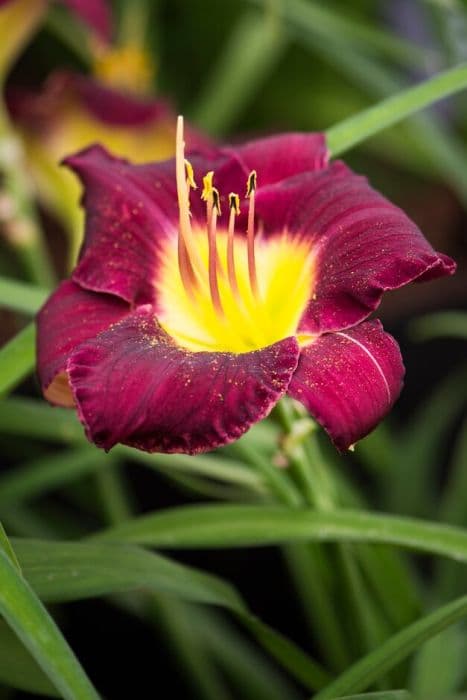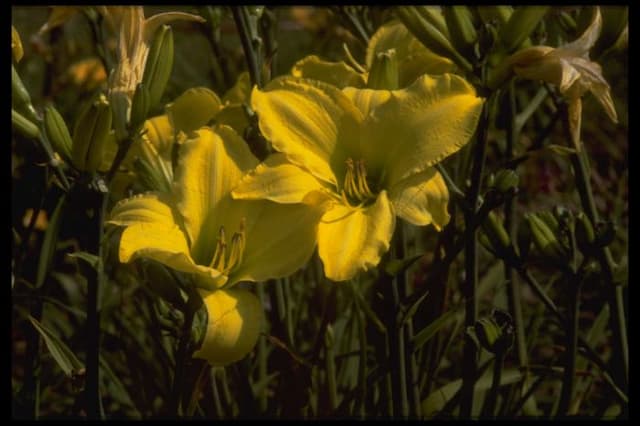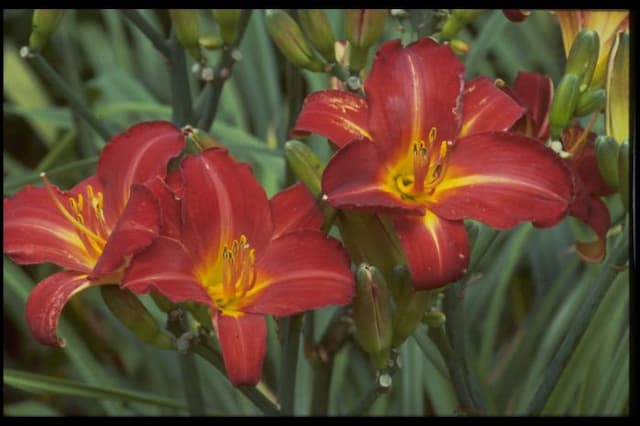Daylily Hemerocallis 'Lark Song'

ABOUT
The Hemerocallis 'Lark Song', commonly known as the Daylily 'Lark Song', is a captivating perennial plant that is widely admired for its strikingly beautiful flowers. The plant is characterized by its bright and lush green foliage, forming a fountain-like clump of narrow, strap-like leaves. The Daylily 'Lark Song' boasts trumpet-shaped flowers, each consisting of three outer petals and three slightly smaller inner sepals that gracefully curve back, creating an open, flared look. These blooms exhibit a lovely light to medium shade of purple, with a subtle gradation of hues that sometimes appear to have a soft, sun-washed quality to them. In the throat of the flower, one can often observe a lighter, perhaps more yellowish or greenish tint, which creates a pleasant contrast with the dominant purple. Completing the allure of the flowers are raised midribs that often appear in a slightly different tone, running the length of the petals and sepals, and providing some textural and visual depth. These flowers are carried on long, sturdy scapes which hold the blooms well above the foliage, allowing them to make a strong visual impact in the garden. Additionally, the Daylily 'Lark Song' produces many blooms per scape, which can lead to an extended display of color when provided with appropriate care and growing conditions. It's worth mentioning that daylilies are known for each flower typically lasting just one day, opening at sunrise and withering at sunset, yet this transient beauty is replaced with new blooms day after day during the flowering period. This capacity for daily rejuvenation lends the plant its common name, daylily, which alludes to this daily cycle of bloom.
About this plant
 Names
NamesFamily
Hemerocallidaceae
Synonyms
Daylily
Common names
Hemerocallis 'Lark Song'.
 Toxicity
ToxicityTo humans
The Hemerocallis 'Lark Song', commonly known as the daylily, is not generally considered toxic to humans. Most parts of the daylily are actually edible when properly prepared and have been consumed in various cultures, especially in Asia. However, as with any plant, individual allergies or sensitivities may exist, so it is always advisable to exercise caution if you are not certain about how you might react to a new plant. It's important to note that not all species related to or similar to the daylily are safe to eat, so proper identification is crucial.
To pets
Daylilies are toxic to pets, especially to cats. Ingestion can lead to a condition known as daylily poisoning. Symptoms in cats may include vomiting, lethargy, kidney failure, or in severe cases, death. It's paramount for cat owners to prevent their pets from having any access to daylilies. Immediate veterinary care is required if there is any suspicion that a cat has ingested any part of a daylily plant. Dogs are less sensitive to daylilies, but they may still experience mild gastrointestinal upset if they consume parts of the plant. It's always best to err on the side of caution and keep daylilies out of reach of all pets.
 Characteristics
CharacteristicsLife cycle
Perennials
Foliage type
Deciduous
Color of leaves
Green
Flower color
Varies
Height
2 feet (0.61 meters)
Spread
2 feet (0.61 meters)
Plant type
Herb
Hardiness zones
3
Native area
Asia
Benefits
 General Benefits
General Benefits- Easy to Grow: The daylily is known for its hardiness and adaptability, requiring minimal maintenance.
- Drought Tolerant: Once established, daylilies can tolerate periods of low water availability.
- Attracts Pollinators: Flowers of the daylily attract butterflies and bees, promoting pollination in the garden.
- Landscape Versatility: Daylilies can be used in various landscape settings, such as borders, ground covers, and slope stabilizations.
- Colorful Blooms: Daylilies have vibrant and colorful flowers that can enhance the aesthetic appeal of any garden.
- Perennial Growth: As a perennial, the daylily returns year after year, providing long-term value for gardeners.
- Rapid Growth: Daylilies establish and grow quickly, covering bare spots in the garden efficiently.
- Edible Parts: Certain parts of the daylily, like the flowers and tubers, are edible, adding an element of utility to its ornamental value.
- Wide Range of Cultivars: The daylily comes in many varieties, offering a broad selection of colors, shapes, and sizes to choose from.
- Tolerates Various Soils: Daylilies are adaptable to a wide range of soil conditions, making them suitable for many gardens.
 Medical Properties
Medical PropertiesThis plant is not used for medical purposes.
 Air-purifying Qualities
Air-purifying QualitiesThis plant is not specifically known for air purifying qualities.
 Other Uses
Other Uses- Hemerocallis 'Lark Song', commonly known as Daylily, can be used as an edible garnish, where the blooms add a splash of color to salads and desserts.
- The fibrous roots of Daylilies can help stabilize soil and prevent erosion on slopes or in areas where ground cover is needed.
- Daylily petals can be used in natural dyeing processes, producing a range of yellow, orange, or green colors depending on the mordant used.
- Dried Daylily flowers are sometimes used in potpourri mixtures for their shape and color retention properties.
- The flowers can be battered and fried, offering a unique culinary experience often found in Asian cuisine.
- In some cultures, Daylilies are planted around homes to provide a protective barrier against negative energies or bad luck.
- Daylily blooms can be pressed and included in craft projects such as pressed flower art or homemade paper making.
- The robust nature of Hemerocallis 'Lark Song' allows it to be used for ornamental purposes in challenging urban environments with poor soil quality.
- Fanciers of Daylilies often engage in hybridization and breeding to develop new varieties, utilizing 'Lark Song' as a genetic parent due to its desirable traits.
- Daylily clumps can provide habitat and shelter for small wildlife, including beneficial insects like bees and butterflies.
Interesting Facts
 Feng Shui
Feng ShuiThe Daylily is not used in Feng Shui practice.
 Zodiac Sign Compitability
Zodiac Sign CompitabilityThe Daylily is not used in astrology practice.
 Plant Symbolism
Plant Symbolism- Daylily - Fleeting Beauty: The Hemerocallis 'Lark Song', also known as the Daylily, embodies the idea of ephemeral beauty, as each bloom typically lasts for just a day. This reflects the concept of carpe diem, or seizing the day, and appreciating each moment.
- Daylily - Motherhood: In Chinese culture, daylilies are associated with motherhood and nurturing due to their prolific nature and the way they care for their offspring, the numerous buds each plant produces.
- Daylily - Forgetfulness and Loss: Historically, the daylily has symbolized forgetfulness and loss, coming from the Victorian language of flowers. Their transient blooms can represent memories or experiences that are fleeting.
- Daylily - Coquetry: In the language of flowers, daylilies can sometimes denote flirtation or a coquettish behavior, perhaps due to the short lifespan of their individual flowers, which could mirror a brief, flirtatious encounter.
 Water
WaterThe daylily, commonly known as the Hemerocallis 'Lark Song', prefers consistent moisture especially during its active growth in spring and early summer. Watering should be done deeply and thoroughly, allowing the top inch of soil to dry out between waterings. Generally, applying about 1 to 2 inches of water per week is sufficient, but this can vary depending on climate and soil conditions. During hot, dry periods, increase the frequency to ensure the plant stays hydrated. Water the plant at the base to avoid wetting the foliage, which can lead to fungal diseases.
 Light
LightDaylilies like Hemerocallis 'Lark Song' thrive in full sun to partial shade. For optimal blooming, position your daylily where it will receive at least 6 hours of direct sunlight daily. Too little light can result in fewer flowers and a weakened plant. A spot with morning sun and afternoon shade can be beneficial in areas with very hot summers.
 Temperature
TemperatureDaylilies such as Hemerocallis 'Lark Song' are adaptable but prefer temperatures between 60 and 75 degrees Fahrenheit. They can withstand colder temperatures down to about -20 degrees Fahrenheit and can survive heat above 90 degrees Fahrenheit if adequately watered. However, extreme temperatures can impact their blooming and overall health, so it's ideal to keep them within their preferred range when possible.
 Pruning
PruningDaylilies should be deadheaded regularly to remove spent blooms and encourage reblooming. Prune back foliage in late fall or early spring to tidy the plant and promote healthy new growth. Divide clumps every three to five years to maintain vigor and flower size.
 Cleaning
CleaningAs needed
 Soil
SoilDaylilies, like Hemerocallis 'Lark Song', thrive in well-draining soil with a pH of 6.0 to 6.5. The best soil mix is one part loam, one part peat moss or compost, and one part perlite or sand for drainage.
 Repotting
RepottingDaylilies such as the Hemerocallis 'Lark Song' typically do not require frequent repotting and are often repotted every 3 to 5 years, or when the clumps become overcrowded.
 Humidity & Misting
Humidity & MistingHemerocallis 'Lark Song', commonly known as Daylily, prefer moderate humidity levels but are quite adaptable and can tolerate a range of humidity conditions found in most outdoor garden settings.
 Suitable locations
Suitable locationsIndoor
Place Daylily 'Lark Song' by a sunny window and ensure proper pot drainage.
Outdoor
Plant Daylily 'Lark Song' in full sun to partial shade with good soil.
Hardiness zone
3-9 USDA
 Life cycle
Life cycleThe life cycle of the Hemerocallis 'Lark Song', commonly known as the Daylily 'Lark Song', starts with seed germination, where the seeds require a period of stratification to break dormancy before they can sprout. After germination, the plant enters a vegetative growth stage where it develops a clump of long, strappy leaves and roots. In subsequent years, this perennial plant experiences seasonal cycles of growth, during which it expands vegetatively, increasing the number of shoots and the size of the root system. Flowering typically occurs in the summer, with each individual flower lasting only one day, though numerous buds ensure a prolonged blooming period. After blooming, if pollination has occurred, the plant may produce seed pods containing seeds that can be dispersed for new plant growth. During the winter, the aboveground parts of the plant die back while the root system remains dormant until the next growth cycle begins in the spring.
 Propogation
PropogationPropogation time
Late summer
Propogation: The Hemerocallis 'Lark Song', commonly known as the daylily, is typically propagated through division, which is the most popular method for this perennial. The best time for dividing daylilies is either in early spring before they begin active growth or immediately after they finish flowering in the summer. To propagate by division, carefully dig up the clump of daylilies, making sure to keep a good amount of the roots intact. Using a sharp knife or spade, divide the clump into smaller sections, each with at least two or three fans of leaves. Replant the divisions at the same depth they were growing at before, spacing them about 18 to 24 inches (approximately 45 to 60 centimeters) apart to allow for adequate growth and air circulation. Water the newly planted divisions well to help establish them. This method is effective because daylilies have a robust root system that recovers quickly from division and continues to thrive.









